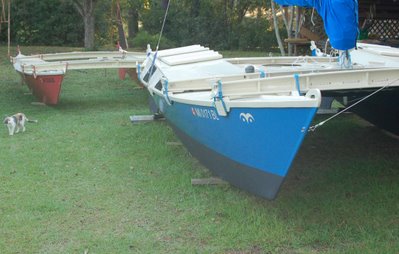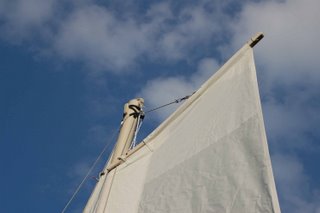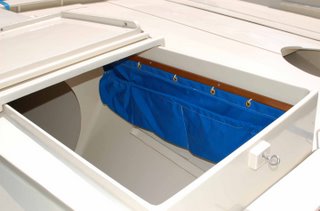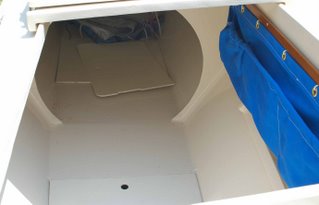Element will finally be afloat again sometime tomorrow. I completed the disassembly and washed the hulls and all parts yesterday, and today will load everything on the trailer for the trip to the beach in Biloxi. I will have help with this from a new Wharram enthusiast who has driven here to Mississippi from Colorado with his son to purchase my other Wharram catamaran, the Hitia 17, Segundo Vez.
Today we will prepare Segundo Vez for the trip to her new home in the Rocky Mountains and finish organizing all the gear needed to sail Element. After launching tomorrow, we will day sail around Biloxi and hopefully sail overnight to the barrier islands that lie approximately 10 miles to the south across the Mississippi Sound.
Tuesday, November 28, 2006
Thursday, November 16, 2006
Hitia 17 and Tiki 21

This photo shows the size difference between my Tiki 21 Element, and my Hitia 17 Segundo Vez. The perspective with Segundo Vez farther away makes it look even smaller, but there is a significant difference in four feet of length. The Tiki range from the Hitia 17 to the Tiki 30 increases in four-foot increments. Each size, however, is almost twice the volume of the next size smaller, hence a Tiki 21 cost about twice as much and requires about twice the time to build as the Hitia 17. This ratio is roughly the same going from a Tiki 21 to a Tiki 26, and from a Tiki 26 to a Tiki 30. In boats volume definately increases at a ratio exponential to overall length.
Each of these four sizes of the Tiki range has its own advantages and disadvantages, making each more suitable for some purposes than others. The Hitia 17 is for sure easier to deal with, with each hull weighing in at only about 90lbs. It can be easily trailered and set up quickly for sailing. What it lacks is any accomodation in the hulls when the weather turns nasty. The Tiki 21 is barely better, but does at least offer much more storage and a dry bunk in each hull, if not room to actually sit up inside with the hatches closed. The Tiki 21 is sort of an in-between size in my view, a little too big and difficult to set-up for easy trailering, at least the kind of trailering where you keep the boat at home and drive to the ramp for a few hours of day sailing. I'll be keeping mine in the water, which means paying for a dock space, which will make sailing much more convenient, but the boat is still too small for living aboard or comfortably hanging around on in a marina setting. It is a boat that will truly be in it's element out there sailing, and should be great for camp cruising and gunkholing around barrier islands and estuaries, while offering the ability to go offshore safely.
Moving up to the Tiki 26 and Tiki 30, one gets into a class of catamarans that are easily capable of long distance bluewater sailing, and both have been well-proven in this regard. The Tiki 26 offers sitting headroom in each hull, as well as two bunks in each and room for a basic galley, a portable toilet and storage for everything needed for one or two people to make an ocean crossing. At just 1500 pounds of boat weight, it still can be trailered, but will be more of a job than the Tiki 21 to assemble/disassemble. The Tiki 30, with it's deeper hulls and more volume inside offers room for a double bunk in each hull, more of a dedicated galley, toilet area, and even more storage. It's a lot more to build in many ways than the Tiki 26, based on my careful study of the plans for each, simply because of the increased size of the scantlings for stringers and other solid parts, the addition of mini-keels in the V-hulls and the complexity of the cockpit, mast, and other details. But it undoubtedly offers more comfort than any of the other small Tikis and the longer waterline length would make for more comfort and speed offshore in rough conditions.
The bottom line is that all boats are compromises, and you must give up one quality to gain another. Having built and sailed the Hitia 17, I'm looking forward to experiencing the capabilities of the Tiki 21. I'll also have one each of the Tiki 26 and Tiki 30, in a perfect world. But seriously, I am going to build another, not only in a quest to get the boat most appropriately sized for my needs, but to control the process from beginning to end so that every part of the boat will be of the best materials and best workmanship I can put into it. More will follow on this, but first there will be more details about the refit of Element, and soon, the sailing and cruising that will follow her launching.
Wednesday, November 15, 2006
Nissan 5HP 4-Stroke Auxillary


Today my new Nissan 4-stroke outboard arrived and to my relief I found that it fit perfectly into the motor mount built into the Tiki 21 bridgedeck by the original builder. This mount is lower than deck level, so the 20" shaft gets the prop well below the waterline and as you can see in the photographs, it does not protrude high above the deck level.
The Nissan/Tohatsu line of outboards come in a 4, 5 and 6 horsepower size, all three of which are the same weight: 55lb.s. I chose the 5 because this size comes with an external fuel tank and line. As I found out long ago on my Hitia 17 with it's 3.3 hp Evinrude, there is nothing more inconvenient than trying to fill a small internal fuel tank when it runs dry in choppy conditions and you end up spilling gasoline all over the engine and the decks. I also wanted forward, neutral and reverse gears, which this engine has, and the quiet, reliability, and fuel economy of a four-stroke.
I found the best price for this engine at www.onlineoutboards.com. I ordered it on Monday and it arrived today, shipped for free via FedEx.
Tuesday, November 07, 2006
About to be Sailing
 The new Jeckells mainsail looks great!
The new Jeckells mainsail looks great!It won't be long now. After all this time I've finally located a place to keep Element in the water on the Mississippi Gulf Coast. It is a great location in the Biloxi area, not at a marina, but secure at a residential dock with easy access to the open waters of the sound and beyond.
Now I'm just finishing up little details like getting the trailer ready to move the boat and putting on a final coat of bottom paint. I'll also order a new outboard and some other gear this week. I'm planning to have a christening on dry land here where I've done the refit this Sunday, then move the boat to the coast to launch as soon as possible after that, depending on my work load and the availability of a couple of friends to help. We'll probably launch off the beach in Biloxi, using the 2-wheeled carts I built to roll the hulls into position across the sand for assembly at the water's edge.
Tiki 21 Interior
I've been asked by readers interested in the Tiki 21 to post some interior shots. There's not much to photograph inside a Tiki 21, but here are a couple of shots I took a few weeks ago after making the canvas storage pockets shown inside the hatches. I'll take some more soon with gear inside, such as sleeping bags, etc. There's lots of storage space under the bunk level in the hulls, as well as extra space forward and aft of the berth area. Each cabin has an open area of 12 linear feet at bunk level between watertight bulkheads.
 Port Hull at hatch entrance, showing canvas storage pockets for items like binoculars and handheld VHF radio that need to be accessible yet safe from going overboard.
Port Hull at hatch entrance, showing canvas storage pockets for items like binoculars and handheld VHF radio that need to be accessible yet safe from going overboard.

Looking forward into the port hull berth. The bunk is just wide enough for a standard 22" Thermarest self-inflating air mattress of the type used by backpackers. Loose hatch boards shown in the photo cover storage areas forward and aft. The bunks feel adequate even though narrow, because of the flaring hull sides that slope away from the sleeping position.
 Port Hull at hatch entrance, showing canvas storage pockets for items like binoculars and handheld VHF radio that need to be accessible yet safe from going overboard.
Port Hull at hatch entrance, showing canvas storage pockets for items like binoculars and handheld VHF radio that need to be accessible yet safe from going overboard.
Looking forward into the port hull berth. The bunk is just wide enough for a standard 22" Thermarest self-inflating air mattress of the type used by backpackers. Loose hatch boards shown in the photo cover storage areas forward and aft. The bunks feel adequate even though narrow, because of the flaring hull sides that slope away from the sleeping position.
Subscribe to:
Comments (Atom)

